Beyond the Four Corners Monument—where the borders of Colorado, Arizona, Utah and New Mexico meet—the region’s majestic landscape and rich human history is diverse and in many ways unparalleled. Overlain by the Colorado Plateau, the area is home to deeply riven canyons, snowcapped mountains, expansive deserts and towering buttes that have attracted people to explore and occupy these contours with reverence for thousands of years.
If you’re considering a trip to the Four Corners of the Southwest, here are just a few epic adventures spanning this matchless quadrant to get you started.
New Mexico
Glamp it up beneath Chaco Canyon’s internationally acclaimed dark sky
In its prime, the mysterious Chaco Canyon—what is now Chaco Culture National Historical Park—was a central gathering place for tens of thousands of Ancestral Puebloan peoples between 850 and 1250 A.D.
“We don’t know why advanced society chose to live [there]—it’s such a hard place to live,” said G.B. Cornucopia, a 30-year guide at Chaco Canyon.
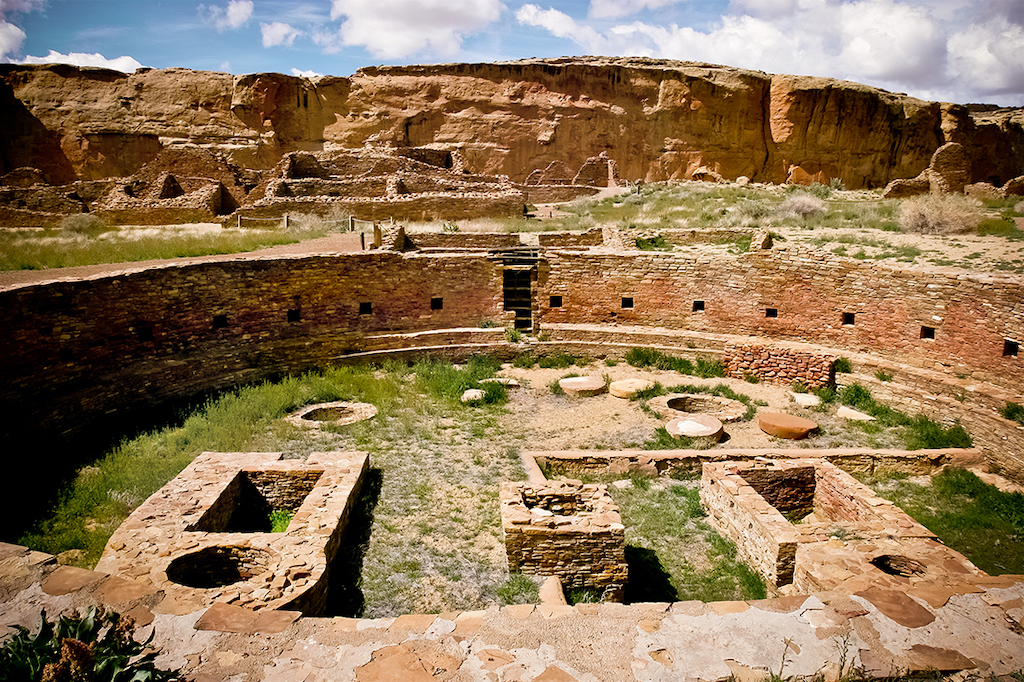
Explore a large Kiva—and tons of other pre-Columbian ruins—in Chaco Culture National Historic Park with REI Adventures.
Visitors today can observe 1,200-year-old remains of elaborate stonework, kivas, plazas, drainages, cliff stairways and petroglyphs panels, which stretch across the 34,000-acre park. But the reach of Chaco went much further. The advanced architecture often aligns with solar, lunar and cardinal directions to create astronomical markers. And uncovered artifacts have origins from thousands of miles away including macaws, turquoise and 181 cylindrical vessels coated with cacao from Central America. In fact, aside from sandstone, nearly all of the materials and food was carried in.
When you go, take the guided tour of Chetro Ketl, which is “the heart of Chaco,” said Cornucopia. And given Chaco’s gold-tier certification as an International Dark Sky Park, the bright stars are the same ones witnessed by the Chacoans. Stay overnight to peer above the domed observatory, pitch a tent at Gallo campground, rent a nearby cabin, or go glamping with Heritage Inspirations guide Angelisa Murray.
Gaze up at Albuquerque’s Mundos de Mestizaje
Mundos de Mestizaje is one of the largest frescoes in North America. A fresco is created on wet lime plaster with water-based pigments: The artist must apply colors during a limited time window, while the wall is damp, and errors are impossible or difficult to recover. This 4,000-square-foot painting fills the interior of El Torreón, a 45-foot tower at Albuquerque’s National Hispanic Cultural Center. Created by master fresco artist Frederico Vigil, the monumental scene depicts thousands of years of Hispanic culture and peoples from the Iberian Peninsula to the Americas.
Carve steep turns at Taos Ski Valley
Skiers and snowboarders might pause at the thought of skiing in New Mexico, but Taos Ski Valley rivals in reputation as one of the region’s most sought-after resorts. Rising to 12,450 feet, Kachina Peak Lift is the fourth-highest lift in North America. Heavy glades preserve the snow, the steep slopes are compact—so laps are quick—and more than half of the trail map is composed of black (expert) runs.
Augment your reality in Santa Fe via Meow Wolf
Meow Wolf is an explorative, immersive art experience that’s taken the country by storm. The original creators, 10 friends in Santa Fe, first hosted collective art shows a decade ago.
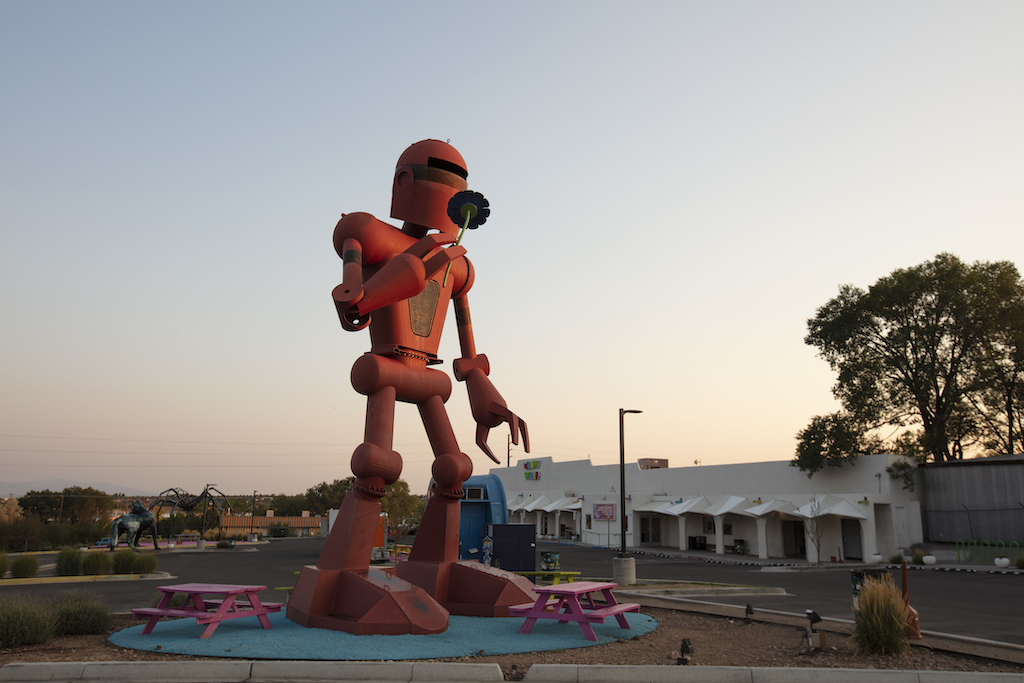
The exterior of Meow Wolf’s House of Eternal Return in Santa Fe, New Mexico. (Photo Credit: Meow Wolf)
But it wasn’t until the inaugural permanent exhibit, “The House of Eternal Return,” launched in March 2016 that these fantastical, avant-garde “realities” garnered national attention: 400,000 visitors—six times the population of Santa Fe—arrived that first year.
Soak in minerals at Ojo Caliente Mineral Springs Resort and Spa
Ojo Caliente Mineral Springs is one of the oldest natural health resorts in the nation. Ojo is also the only hot springs in the world that holds four sulfur-free, mineral-loaded soaking pools. For one, the Kiva Pool—designed after the ceremonial kivas of the ancestral Puebloans—is filled with iron and arsenic mineral waters, which are considered to be beneficial for blood flow, immunity, fatigue prevention, skin tone, digestive issues and arthritis. But the Mud Pool—where you can lather yourself in mud, then bake dry—is also a perennial favorite.
Arizona
Browse the wares at historic Hubbell Trading Post
The Hubbell Trading Post National Historic Site has been an epicenter for the exchange of art and utility goods since 1878—and it’s still operating. The site is the original trading post of the Navajo Nation, a 27,000-square-mile reserve for the Diné people, the largest indigenous tribe in the country. Tour the historic house of the Hubbell family to be inspired by their collection of Southwestern art. Then browse the trading post’s authentic locally woven rugs and stroll the Veterans Trail along the Pueblo Colorado Wash.
Revel in the cosmos at Lowell Observatory
From the discovery of Pluto to moon-mapping for NASA’s Apollo program, Lowell Observatory just outside Flagstaff has been a major player in countless discoveries since it opened in 1984. Visitors can view the sun or other stars through a solar telescope and attend educational programs on cosmology topics such as the life and death of stars.
Backcountry hike (and photograph) Monument Valley (Tsé Bii’Ndzisgaii)
“The last time I hiked on Wildcat Trail, I didn’t see another soul,” said Paula Koren, manager of the REI Flagstaff store and a 25-year resident of Northern Arizona—regarding the 3.2-mile loop around West Mitten Butte. “A lot of visitors take tours with the tribal guides,” said Koren, such as a jeep cruise through the sandstone formations to access special landmarks.
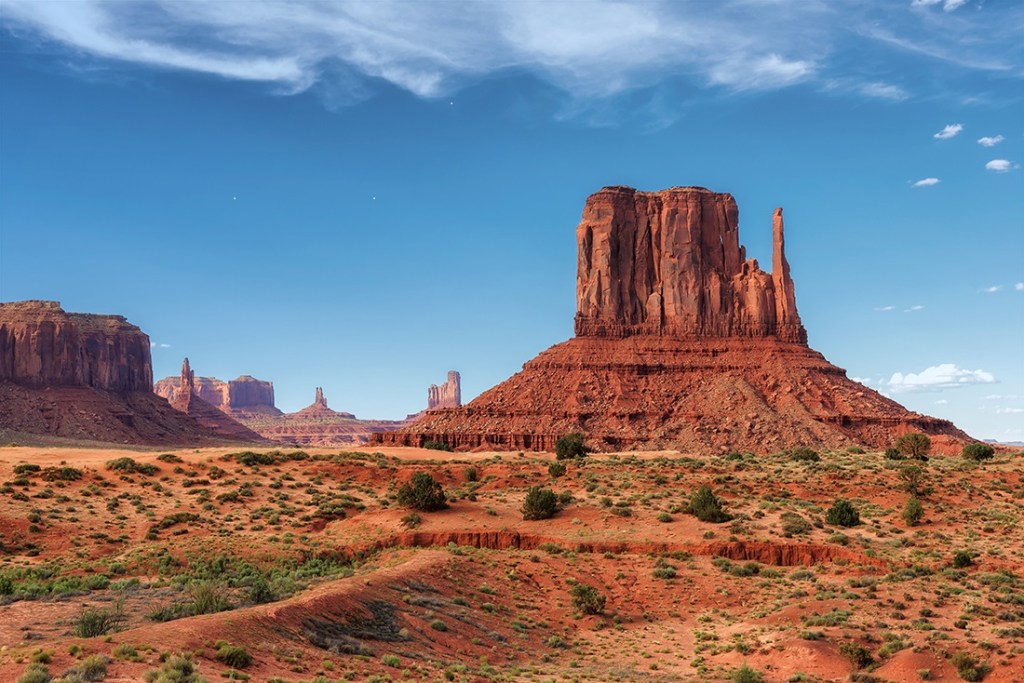
Discover Sandstone buttes rear into the sky in Monument Valley, Utah with REI Adventures
Wildcat Trail is the only official path in Monument Valley Tribal Park, a world-famous red-desert domain known for its distinctive buttes—East Mitten, West Mitten and Merrick—which tower up to 1,000 feet above the shrub-speckled earth. In great part, Monument Valley has been popularized by its appearance in countless films such as the 1962 release, How the West Was Won.
Look over the rim at Canyon de Chelly National Monument
For close to 5,000 years, people have inhabited what is now known as Canyon de Chelly National Monument—the longest uninterrupted community on the Colorado Plateau. Today, Diné families live and farm in the canyons while working cooperatively with the National Park Service to manage the land’s resources.
The sole established route in Canyon de Chelly (pronounced Canyon de-Shay) is The White House Trail, which leads travelers to the White House Ruin. The 2.5-mile out-and-back route ascends a total of 600 feet. Don’t miss the North Rim Drive and South Rim Drive to visit 10 overlooks that yield views of the area’s impressive topography.
Colorado
Experience lift-served backcountry at Silverton Mountain
Surrounded by the rugged San Juan Mountains, Silverton Mountain is one of North America’s highest-elevation ski areas. Skiers and riders board the single antique two-seater chair (beacon, shovel and probe required) to reach the 12,300-foot high cirque—where they can bootpack another 1,000 feet—and drop into ungroomed backcountry bowls, couloirs, ridgelines and glades that span 1,819 acres.
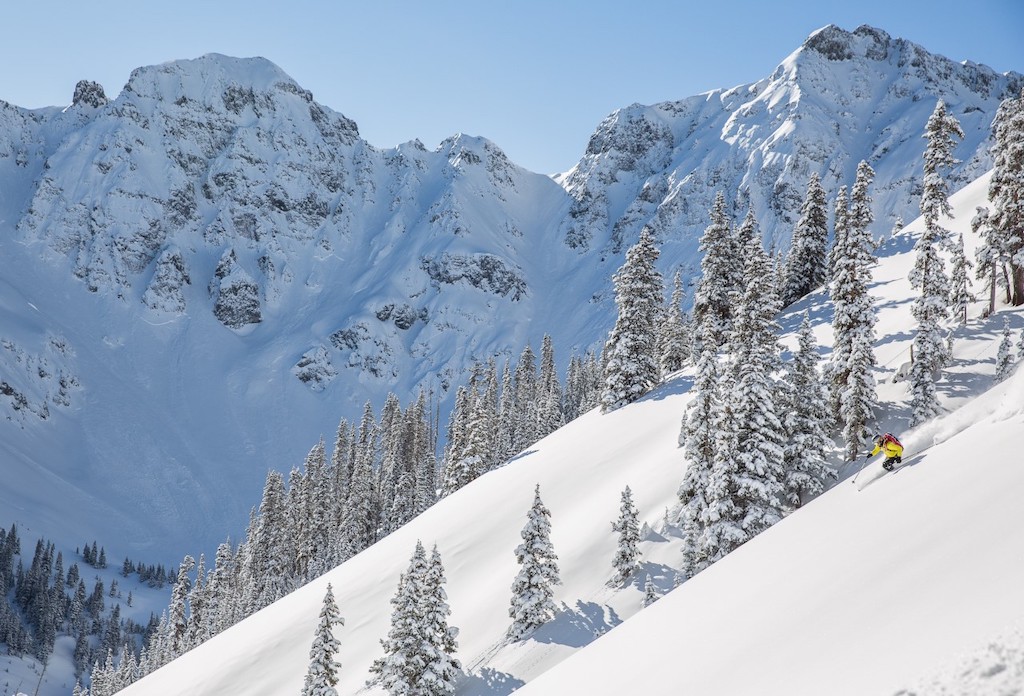
A skier enjoys untouched powder at Silverton Mountain in Southwest Colorado. (Photo Credit: Silverton Mountain)
“Silverton Mountain is extremely unique and the best of all worlds: You don’t have to kill your legs getting uphill but still get the money shot while staring at incredibly aggressive lines. … And there’s not many people out there, especially on a weekday,” said Graham Coffey, manager and buyer at Backcountry Experience in Durango, Colorado.
Swing an ice axe at the Ouray Ice Park
Over the past two decades, Ouray Ice Park—the world’s first official ice park—has become an ice climbing capital for the country and globe. Each winter, ice farmers spray water down the canyon walls of the Uncompahgre Gorge. The result? A one-mile stretch of more than 200 manmade ice and mixed climbs that accumulate a total of 16,000 vertical feet. “An environment with hundreds of pitches that can be simultaneously climbed gives a rare community feel because usually in the backcountry, groups can’t climb side by side,” said Coffey.
Rewind time at Mesa Verde National Park
The Ancestral Puebloans prospered in the Four Corners region 1,400 years ago—and left behind a masterful collection of architecture. Today, Mesa Verde National Park protects close to 5,000 archaeological sites, including 600 cliff dwellings created by these ancient peoples. Coffey explained that he was originally from North Carolina and that “Mesa Verde is a piece of the nation’s history that you don’t learn much about in school or museums—even though, it predates European settlers. It was a booming metropolis, which is mind-boggling.”
Mesa Verde’s population peaked at close to 5,000 people in the 1200s CE—about five times the size of the park’s nearby town, Dolores. Don’t miss the ranger-led tours of Cliff Palace and Balcony House.
Pedal singletrack at Phil’s World
The meandering roller-coaster loops of Phil’s World trail system trace the high desert and offer an extended mountain bike season for folks who live at higher elevations. From the singletrack, you can catch stunning views of snowcapped peaks in every direction from the La Plata Mountains and the Wilson Group to the Abajo Mountains and the La Sal Mountains. Rib Cage, the trail’s most widely celebrated segment, is a slice of surfy rollers, optional airtime, and tons of hoots and hollers.
Sip a pint (or two) at Durango’s Ska Brewing Co.
Ska Brewing Co. is to Durango what Budweiser is to St. Louis: “Ska is a quintessential institution of the town of Durango. Everybody supports them and they support the community at large. For store events, we will often serve Ska beers,” said Coffey—and he doesn’t even drink.
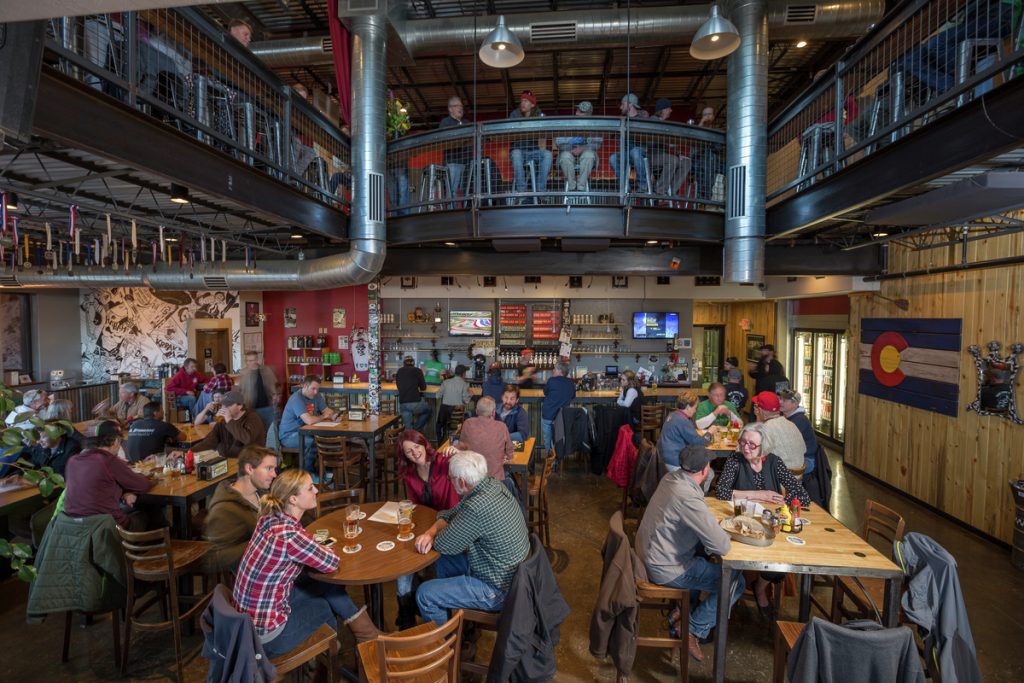
Locals and visitors intermingle and enjoy craft brew at the Ska Brewing tasting room. (Photo Credit: Ska Brewing Co.)
To sip on legendary beers like Euphoria and Decadent to old standbys like Pinstripe and True Blonde, plus tons of seasonal offerings, stop by Ska’s tasting room to try the award-winning variety the brewery has on tap daily.
Utah
Explore the Valley of the Gods
“Valley of the Gods is magnificent! It’s isolated and breathtaking,” said Anderson about the sculpted region that’s chock-full of monoliths, buttes and pinnacles. The formations have been created by weathered Cedar Mesa sandstone—which dates to 250 million years ago. Journey down the Trail of the Ancients National Scenic Byway and, if conditions are dry, rather than turning at the junction of US Route 163 to State Route 261, take the 17-mile dirt road through the valley (editor’s note: the BLM advises avoiding this road in wet weather, as it crosses numerous washes).
Paddle past ancient artifacts along the San Juan River
An adventure down Utah’s San Juan River connects paddlers to red canyons steeped in archaeological wonder and magnificent geography. “As you raft or kayak the San Juan River, you can see petroglyphs from every era since humans have walked [the region]. … You can get out of your boat, walk right up to [art panels], and there are layers upon layers of history,” said Cimarron Anderson, who was named an REI Top Guide of 2019 and who specializes in Southwestern U.S. and Four Corners backpacking.
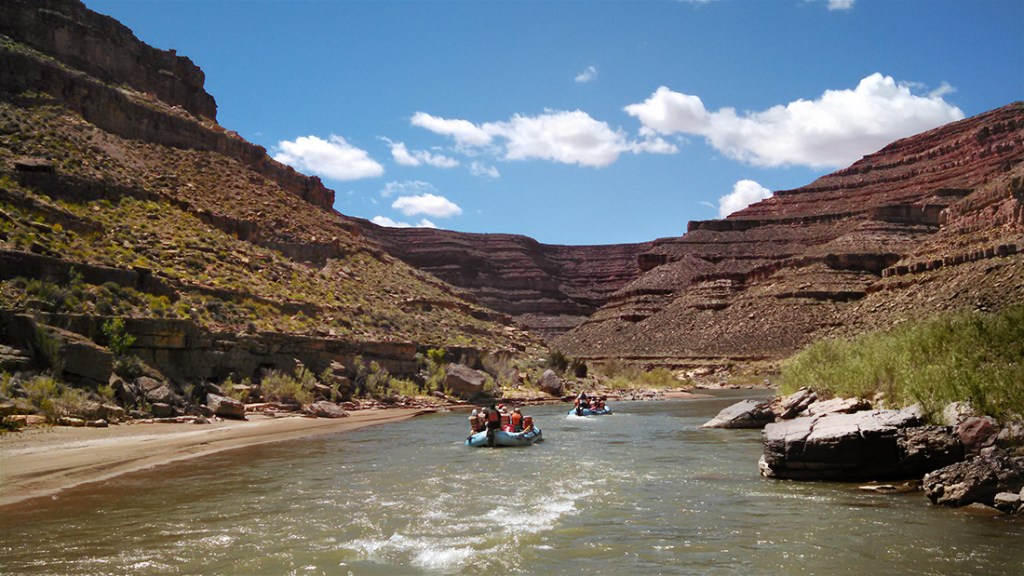
Boaters enjoy the placid waters and incredible scenery of the San Juan River with REI Adventures.
From the river’s Colorado headwaters, the San Juan flows 360 miles until it reaches Glen Canyon National Recreation Area. En route, the water joins the southern boundary of Shash Jáa—a unit of Bears Ears National Monument (as redrawn in 2017)—where the moderate whitewater rapids oscillate from a class I to II in difficulty.
Mountain Bike the White Rim in Canyonlands National Park
Often spoken of as the “raft trip of mountain biking,” due to the gluttonous amount of supplies that can be carried by a follow vehicle, the 100-mile ride along the White Rim Road can be as plush—or as bare-bones—as you wish.
“White Rim is an extreme physical feat if you ride it in a day, and if you ride it in multiple days, it’s a challenging logistical feat: You need to bring all of your water, food and camping gear. People usually have a follow vehicle and trade off driving,” said Amrah Hubbard, manager of Chile Pepper Bike Shop in Moab, Utah.
Located inside Island of the Sky, bikers descend to a mesa where they traverse and soak up the expansive sights and deep gorges of Canyonlands National Park. The logistics are well-worth the effort: “Scenery is second to none—it feels like you’re in the Grand Canyon. The vast, expansive desert gives way every 100 feet to crevasses and infinite canyons while views of the La Sal Mountains, Abajo Mountains and Henry Mountains peek through the valley,” said Hubbard.
Hunt for petroglyphs in the Bears Ears cultural land
“Bears Ears is my favorite place to go on [my] own and with a curious mind. It’s fun to stumble upon and experience petroglyphs and artifacts, and it needs to be done with respect and protection in mind. I love that there are not that many people, and the dirt roads seem to continue forever,” said Anderson. Check out, The Best Bears Ears National Monument Hikes, written by Morgan Sjogren (editor’s note: the monument was greatly reduced in size in 2017).
Stand up paddle board at Lake Powell
Lake Powell—the largest human-made lake in North America—rests in Glen Canyon National Recreation Area. When full, this reservoir stretches 186 miles in length and boasts close to 2,000 miles of shoreline, plus 96 major side canyons. Paddle your SUP for an afternoon or take a multiday excursion that links sandy beaches, amber-rock gorges and sandstone formations.
Pull some sandstone at Indian Creek
Indian Creek, a longtime rock climbing destination, was recently designated a unit of Bears Ears National Monument. Known by climbers as “the Creek,” the area of Wingate sandstone cliffs rose to stardom due to its prolific concentration of vertical cracks—called splitters—in the rock. Bear Ears is co-managed by the U.S. Forest Service, the BLM and five Native American tribes.
Thousands of lines are available for crack climbing: splitters (perfect cracks in a rock that fit hands and feet); chimneys (a crack that’s wide enough to fit a climber’s body); and off-widths (a crack that’s too narrow for a body, yet too wide for hands and feet.) Motor west from U.S. 191 along the Indian Creek Corridor Scenic Byway (S.R. 211) to scope out the crack climbing, and don’t miss Newspaper Rock (Tse’ Hane), 15 miles from the junction: a panel of petroglyphs with more than 650 figures that date back more than 2,000 years.
The Southwestern Four Corners has many adventures waiting for you and your family. Take a trip back in time today!
